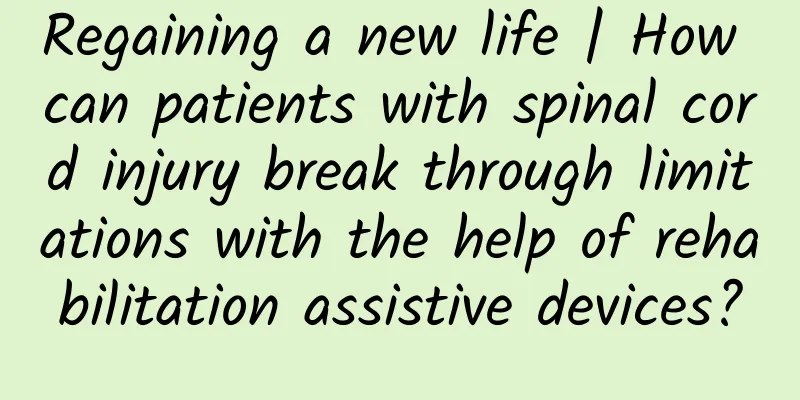Regaining a new life | How can patients with spinal cord injury break through limitations with the help of rehabilitation assistive devices?

|
Spinal cord injury patients, application of rehabilitation assistive devices Spinal cord injury, how to choose suitable rehabilitation assistive devices? Spinal cord injury is a damage to the structure and function of the spinal cord caused by various pathogenic factors, resulting in impairment of spinal cord function (movement, sensation, reflex, etc.) below the level of injury. It is a serious disabling injury that often leads to varying degrees of paraplegia or quadriplegia, and in severe cases affects the patient's ability to take care of themselves and participate in social activities. Note: Cited from "Sports Therapy and Occupational Therapy (Second Edition)" by Dui Sheng and Yun Xiaoping Damage level (1) Cervical spinal cord injury: Upper cervical spinal cord injury: The patient suffered from quadriplegia, cervical spinal cord injury above C4, and complete paralysis of the respiratory muscles of the diaphragm and abdominal muscles, manifesting as extreme difficulty breathing and cyanosis. If tracheotomy is not performed in time to control breathing, the patient's life will be in danger. Lower cervical spinal cord injury: The patient may experience quadriplegia from the shoulders down, a small chest breathing amplitude, shallow abdominal breathing due to diaphragmatic movement, and loss of bowel and bladder functions. Due to sympathetic nerve disorder after cervical spinal cord injury, the patient loses sweating and vasoconstriction function, and the patient may have central hyperthermia with a body temperature of over 40°C. There are also cases of persistent hypothermia. For lower cervical spinal cord injuries, the upper limbs may retain some sensory and motor functions. (2) Thoracic spinal cord injury: The patient presents with paraplegia, and if it is T1 or T2, there may be sensory and motor disorders in the upper limbs. Other thoracic spinal cord injuries manifest as loss of sensory, motor, and bowel and bladder functions below the injury level, inability to elicit superficial reflexes, including abdominal wall reflexes and cremasteric reflexes, while knee tendon reflexes and Achilles tendon reflexes are active or hyperactive, lower limb muscle tension is significantly increased, patellar clonus occurs, and Babinski sign and Chaddock sign are positive. (3) Injury of lumbar cord and conus medullaris: After L1-S1 spinal cord injury, there is sensory impairment below the lower back and groin. Transverse damage above the L1 segment is manifested as increased muscle tone of the lower limbs, hyperreflexia of the tendons, and pathological signs. Injuries below the L2 segment are manifested as decreased muscle tone of the lower limbs, disappearance of tendon reflexes, and no pathological signs. Injuries to the conus medullaris have normal sensory and motor functions of the lower limbs. The skin of the perineum is saddle-shaped with decreased or absent sensation, detrusor paralysis, and a tensionless bladder, resulting in filling urinary incontinence, loss of control of urination and defecation, and disappearance of anal reflexes and bulbospongiosus reflexes. (4) Cauda equina syndrome Below L2 is the cauda equina nerve . Damaged nerves below this level can cause sensory and motor dysfunction, and bladder and rectal dysfunction. Why is it necessary to intervene with rehabilitation assistive devices? Preventing complications Long-term bed rest or functional impairment can easily lead to a series of complications, such as muscle atrophy, joint stiffness or pressure sores. Rehabilitation assistive devices can reduce the risk of complications by adjusting posture and promoting activities. Compensation for missing functionality Spinal cord injury causes partial loss of body functions. Rehabilitation assistive devices can replace or compensate for these functions, helping patients complete restricted movements and activities so that they can better adapt to the needs of daily life. Increased independence in daily living By using assistive devices, patients can perform daily activities such as dressing, eating or moving more independently, thereby reducing their dependence on others and enhancing their self-management ability. Promoting social participation Rehabilitation assistive devices can help patients restore certain social functions, enabling them to re-participate in work, study or recreational activities, thereby improving their mental state and increasing their life satisfaction. When to introduce rehabilitation assistive devices? Acute phase: Spinal cord injury or within 4 weeks after surgery (1) Orthoses for fixation and protection: including neck braces, waist collars, etc. Used for fixation and stabilization of the cervical and lumbar vertebrae. (2) Anti-pressure sore pads: including various types of body positioning pads, anti-pressure sore mattresses, etc. They are used to reduce local pressure on bony protrusions of the body, balance body pressure, promote blood circulation, and prevent pressure sores. (3) Auxiliary devices for turning over and sitting up: including wedge-shaped cushions, etc. Used for turning over and changing body positions such as lying on the back. Recovery period: After spinal cord injury or 4 weeks after surgery (1) Standing frame: used for training people who have lost their posture sense and balance reaction ability to re-establish standing posture. (2) Walker: supports body weight, reduces the load on the lower limbs, and assists in standing and walking training. (3) Orthotics: including hip-knee-ankle-foot orthoses, knee-ankle-foot orthoses, ankle-foot orthoses, alternating paraplegic walkers, etc. They stabilize the knee and ankle joints and assist in standing and walking; they can be used together with a standing frame and a wheelchair as needed. (4) Wheelchairs: including ordinary wheelchairs, electric wheelchairs, high-back wheelchairs, etc. They are means of transportation used for transfer and movement. (5) Crutch: According to the different shapes, structures and functions of the crutch, it can be divided into cane, elbow crutches, forearm support crutches and axillary crutches. People with lumbar injuries can use ankle-foot orthoses, axillary crutches, canes and elbow crutches to walk. (6) Assistive devices for self-care: Commonly used assistive devices for self-care include those for dressing, eating, washing, bathing, toileting, and retrieving items. Rehabilitation engineering plays a particularly important role in spinal cord injury. Through customized rehabilitation assistive devices, it helps patients perform daily activities more independently, which not only improves the quality of life of patients, but also greatly promotes their autonomy and social participation, providing solid support for the rehabilitation and reintegration of spinal cord injury patients. END |
Recommend
How much does it cost to check for leucorrhea
Routine vaginal discharge testing is a common and...
How is vulvovaginal candidiasis treated?
Female candidal vaginitis, also known as candidal...
What to do if you have stomach pain during 6 months of pregnancy
During pregnancy, stomach pain is a common sympto...
The difference between cervical bleeding and menstruation
For women, cervical cancer is a very terrible dis...
Can I have an abortion at five weeks of pregnancy?
The 5th week of pregnancy means that you are very...
What are the symptoms of monthly fatigue disease
In simple terms, menstrual disease is a disease t...
What should patients with hypertension do during the epidemic? What should patients with hypertension eat during the epidemic?
Recently, the new coronavirus is at its most tens...
[Health Lecture] "Will you become stupid after having your bone marrow extracted?" — Let's help you understand bone marrow puncture correctly
In order to ensure the popularization effect of l...
Why does the skin age?
Anti-aging can be said to be one of the mainstrea...
Food nutrition science popularization - Does reheating rice cause cancer? These foods are not suitable for reheating
As a traditional virtue of the Chinese nation, I ...
Inverted nipples with white discharge should be corrected and treated in time
Inverted nipple is a deformed nipple, which is of...
What to do if cracks appear on the wall after one year of renovation? Method of applying latex paint on putty wall
The paint in my home has cracked after one year o...
A 1cm live worm was removed from the boy’s eye. Pet parasites must be prevented!
Audit expert: Wu Lei National licensed veterinari...
What is normal for leucorrhea?
Generally, the shape of leucorrhea is relatively ...
What are the harms of having sex during menstruation to women?
A healthy sex life is a lubricant in the marriage...









